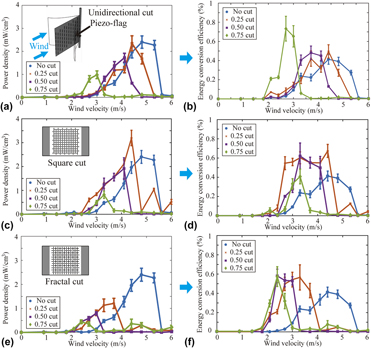Crossref Citations
This article has been cited by the following publications. This list is generated based on data provided by
Crossref.
Fang, Lichen
Li, Jing
Zhu, Zeyu
Orrego, Santiago
and
Kang, Sung Hoon
2018.
Piezoelectric polymer thin films with architected cuts – CORRIGENDUM.
Journal of Materials Research,
Vol. 33,
Issue. 17,
p.
2646.
Cui, Huachen
Hensleigh, Ryan
Yao, Desheng
Maurya, Deepam
Kumar, Prashant
Kang, Min Gyu
Priya, Shashank
and
Zheng, Xiaoyu
2019.
Three-dimensional printing of piezoelectric materials with designed anisotropy and directional response.
Nature Materials,
Vol. 18,
Issue. 3,
p.
234.
An, Ning
Domel, August G.
Zhou, Jinxiong
Rafsanjani, Ahmad
and
Bertoldi, Katia
2020.
Programmable Hierarchical Kirigami.
Advanced Functional Materials,
Vol. 30,
Issue. 6,
Li, Yanbin
Song, Xiaolei
Liu, Haijun
and
Yin, Jie
2021.
Geometric mechanics of folded kirigami structures with tunable bandgap.
Extreme Mechanics Letters,
Vol. 49,
Issue. ,
p.
101483.
Xu, Zhe
Jin, Congran
Cabe, Andrew
Escobedo, Danny
Gruslova, Aleksandra
Jenney, Scott
Closson, Andrew B.
Dong, Lin
Chen, Zi
Feldman, Marc D.
and
Zhang, John X. J.
2021.
Implantable Cardiac Kirigami‐Inspired Lead‐Based Energy Harvester Fabricated by Enhanced Piezoelectric Composite Film.
Advanced Healthcare Materials,
Vol. 10,
Issue. 8,
Wang, Yafei
and
Wang, Changguo
2021.
Buckling of ultrastretchable kirigami metastructures for mechanical programmability and energy harvesting.
International Journal of Solids and Structures,
Vol. 213,
Issue. ,
p.
93.
Zhou, Xinran
and
Lee, Pooi See
2021.
Three dimensional printed nanogenerators.
EcoMat,
Vol. 3,
Issue. 3,
Wu, Honghui
Zhuo, Fangping
Qiao, Huimin
Kodumudi Venkataraman, Lalitha
Zheng, Mupeng
Wang, Shuize
Huang, He
Li, Bo
Mao, Xinping
and
Zhang, Qiaobao
2022.
Polymer‐/Ceramic‐based Dielectric Composites for Energy Storage and Conversion.
ENERGY & ENVIRONMENTAL MATERIALS,
Vol. 5,
Issue. 2,
p.
486.
Jalali, Ehsan
Soltanizadeh, Hadi
Chen, Yao
Xie, Yi Min
and
Sareh, Pooya
2022.
Selective hinge removal strategy for architecting hierarchical auxetic metamaterials.
Communications Materials,
Vol. 3,
Issue. 1,
Kim, Young-Gyun
Song, Ji-Hyeon
Hong, Seongheon
and
Ahn, Sung-Hoon
2022.
Piezoelectric strain sensor with high sensitivity and high stretchability based on kirigami design cutting.
npj Flexible Electronics,
Vol. 6,
Issue. 1,
Song, Ji‐Hyeon
Kim, Young‐Gyun
Cho, Younggyun
Hong, Seongheon
Choi, Jun Young
Kim, Min‐Soo
and
Ahn, Sung‐Hoon
2023.
Stretchable Strain and Strain Rate Sensor Using Kirigami‐Cut PVDF Film.
Advanced Materials Technologies,
Vol. 8,
Issue. 6,
Zhou, Xinran
Parida, Kaushik
Chen, Jian
Xiong, Jiaqing
Zhou, Zihao
Jiang, Feng
Xin, Yangyang
Magdassi, Shlomo
and
Lee, Pooi See
2023.
3D Printed Auxetic Structure‐Assisted Piezoelectric Energy Harvesting and Sensing.
Advanced Energy Materials,
Vol. 13,
Issue. 34,
Zhang, Zhennan
Jiang, Huan
Bednarcyk, Brett A.
and
Chen, Yanyu
2023.
Greek Key Inspired Fractal Metamaterials with Superior Stretchability for Tunable Wave Propagation.
Advanced Materials Technologies,
Vol. 8,
Issue. 21,
Wang, Junlei
Sun, Zeye
Hu, Guobiao
Ding, Hongbo
and
Li, Xinliang
2024.
Improving mechanical energy harvesters without complex fabrication using origami/kirigami.
Device,
Vol. 2,
Issue. 9,
p.
100548.
Wei, Jiaqi
Hu, Xiaopin
Li, Yirui
Bian, Zhiyao
Yan, Kang
and
Wu, Dawei
2025.
3D-printed piezoelectric ceramics with auxetic structure for high-performance sensing applications.
Ceramics International,
Vol. 51,
Issue. 2,
p.
2509.
